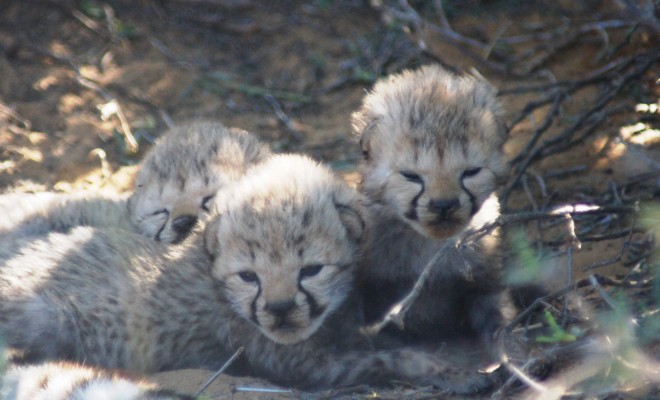Cheetah conservation seems to be playing a game of tug-of-war. In recent months there have been several announcements of various litters of this threatened big cat being born in southern Africa and even abroad. But this positive news is counteracted by the increased poaching of cheetahs from Africa for trade in the Middle East.
Cheetah Cubs Born
At Inverdoorn Game Reserve in the Western Cape province of South Africa, a litter of four cubs was born in May this year to an unrelated breeding pair in their cheetah rescue and rehabilitation centre, Western Cape Cheetah Conservation. The female cheetah, Lotta, is a first-time mother, and because females tend to continue producing litters once they have bred successfully, there is hope that Lotta will have more litters in future.
At Mountain Zebra National Park in the Eastern Cape, three cubs were born to the cheetah Samara. The birth is estimated to have taken place in late December last year, or perhaps early January this year. The cubs’ father is Phinda, a male cheetah introduced to the park from KwaZulu-Natal as part of a genetic exchange programme. As a result these cubs, like those from Inverdoorn, add much-need diversity to the cheetah gene pool.
Further afield, in the Netherlands, a litter of six cubs was born at Burgers’ Zoo in Arnhem in May this year. The cubs have just been unveiled to the public, spending their first weeks alone with their mother in order to minimise stress, as newborn cheetahs are highly susceptible to infant mortality.
From private game reserves and national parks to international zoos, cheetah conservation is taking the necessary strides in the race the save the world’s fastest living land mammal.
Cheetah Smuggling
The dark side of cheetah conservation is the rise of poaching for the trade of these big cats in the Middle East, where they are sold as pets. These cheetahs lead miserable lives indoors away from their natural environment, running on treadmills and paraded as status symbols by their owners who travel with them in cars through the city. Moreover, two-thirds of the cubs that are smuggled do not survive the arduous journey.
Along with habitat loss and conflict with farmers, this illegal trade threatens cheetahs in the wild and is pushing the population to extinction. With less than 10 000 cheetahs left in the wild in Africa – and less than 100 Asiatic cheetahs left in Iran – this threatened animal cannot risk further pressure on its decreasing populations. Exacerbating these problems is the demand for cheetahs in North and West Africa, who use the skin for clothing, and bones and other body parts for traditional medicine and magic rituals.
Much of the latter is entrenched in centuries-old customs and tradition. The greater concern is that increased wealth in certain nations is leading not only to increased demand for luxury products, but also the creation of new luxury products. This trend has been dubbed “health to wealth” – a demand which is merely meant to satisfy new-found status and power.
The Cheetah Challenge
Conservation is a bewildering and daunting task. One of these is facing the challenge of subverting old belief systems about the use of animals. With a youth that is both aware and concerned about their environment, one of the keys lies in education and continued awareness. This has already been broached in many forms, including public-awareness campaigns; while conservation work undertaken by national parks, game reserves and zoos remains important in increasing and diversifying the cheetah population.
Contrary to increased concern for the environment and conservation, is the struggle of our times as obtaining luxury and power becomes more accessible to people through technological advancement. But as these same tools can be used by conservationists, governments, private organisations and the public it becomes imperative that we use them to counter negative impacts on the environment. Through awareness, enlightenment and involvement we can understand threats and how to respond to them so that our access to a global network can help us save cheetahs, as well as other wildlife and, by extension, ourselves.
Originally published on Afrilodge.
